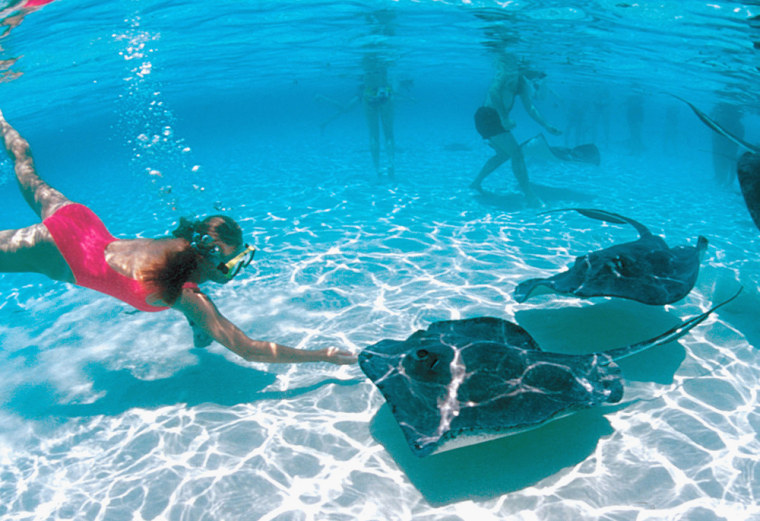It’s one of the most popular excursions for cruise travelers in the Caribbean: swimming with stingrays. The untimely death of Australian naturalist Steve Irwin, who was killed by a stingray barb last week, has many people asking questions, mainly, “Is it safe to go in the water with these ordinarily docile creatures?”
Stings happen
Over the years, I have taken many stingray tours and all of them have been enjoyable. While my own experiences have been terrific, I did recently see someone get injured during a stingray tour near Grand Turk (Turks and Caicos). It happened soon after a young man in our tour group began feeding a group of stingrays. In the ensuing excitement, the young man lost his balance and fell down. As he got up, he accidentally stepped on a ray’s tail and a barb entered his foot.
To see this strapping young man in excruciating pain was difficult. Our tour was immediately called off, and everyone quickly piled into the tour boat to rush the man back to the ship’s medical center. Fortunately, the young man was OK; unfortunately, he had to get a lot of stitches and spent the rest of his vacation on crutches.
Stingrays are ordinarily docile creatures, but they are wild animals nonetheless, and certain precautions must be taken around them.
Stingrays 101
According to Alan Henningsen, a noted marine biologist who serves as the fishes research specialist for the National Aquarium in Baltimore, the most common stingray encountered in Caribbean waters is the “Southern Stingray.” These docile creatures can be found in shallow beach waters, on sandy bottoms, over sea grass beds, in lagoons and near reefs, where they feed mainly on crabs, clams, shrimp, marine worms and small fish. Henningsen says female southern stingrays have a maximum disc width of 6½ feet (which is larger than their male counterparts); the largest recorded weight of this species is 300 pounds. Stingrays have few natural predators other than the occasional large shark and are not targeted by commercial fisheries.
Henningsen says that with proper precautions, everyone can safely appreciate the graceful beauty of stingrays up close. People just need to remember that stingrays have long, whiplike tails with one or more razor-sharp, serrated barbs, which they use for defense.
“Stingrays only flick their barbs upwards in an involuntary reflex action if they feel threatened, as a defensive measure when it is caught, stepped on or otherwise disturbed,” Henningsen says.
The stingrays that most cruise passengers encounter have been artificially concentrated in some areas by resort owners and divers who have established regular feedings that attract them. These local populations are now major tourist attractions in some areas like Grand Cayman. Henningsen says recent research has shown major differences in behavior between wild stingrays that are fed by humans and wild stingrays that feed on their own. Most notably, the human-fed rays come to behave more like captive rays.
Most stingray injuries occur on the legs or feet after unwary people step on or disturb the animals in shallow water. It is clearly dangerous to swim directly over a stingray (this is how Steve Irwin was fatally injured). In general, if you aren’t on a tour, it is advisable to avoid stingrays, and you should certainly leave them alone while diving or snorkeling.
If a person is stung, it’s important to control any bleeding, get hot water on the area (this eases the pain by breaking down the venom protein) and seeking medical attention.
Cruise line and tour reaction
When I spoke with Carnival Cruise Lines spokesman Vance Gullicksen, he lamented Steve Irwin’s death as a terrible tragedy and added that Carnival has informed guests that stingray injuries are extremely rare. “We have had tens of thousands of our guests participate in the stingray shore excursions offered by our tour-operator partners,” Gullicksen said, “and there has never been a fatality or serious injury.”
Royal Caribbean International stated it had not changed any stingray excursions that the cruise line offers. Royal Caribbean representative Lyan Sierra-Caro stated that the cruise line had not seen an increase in questions from passengers, either. “I think everyone understands that this [Irwin’s death] was a rare circumstance,” she said.
I also spoke with several Grand Cayman tour companies that operate tours to Stingray City, one of the most popular stingray gathering grounds in the Caribbean; none has experienced cancellations because of Steve Irwin’s death. The Cayman Islands Tourism Association water sports directors had not heard of cancellations from members, either.
According to statistics, there have been only 17 stingray deaths recorded worldwide. While what happened to Steve Irwin is a tragedy, Henningsen notes it’s extremely rare to have a vital organ punctured by a stingray barb. According to the fishes expert, “You have a better chance of winning the Powerball lottery than dying from a stingray barb.”
Have a cruising question or issue for Anita? Feel free to e-mail her.
Tripso wants to take you on a cruise for a cause! See how far New Orleans and Cozumel have come since Katrina and Wilma. Join us October 26, 2006, for four nights on Carnival’s Fantasy, one of the vessels that Carnival offered for hurricane relief. Chat with your favorite Tripso columnist and contribute to a worthy Gulf Coast relief organization. Space is very limited. For more information, e-mail us or check out our cruise page.
